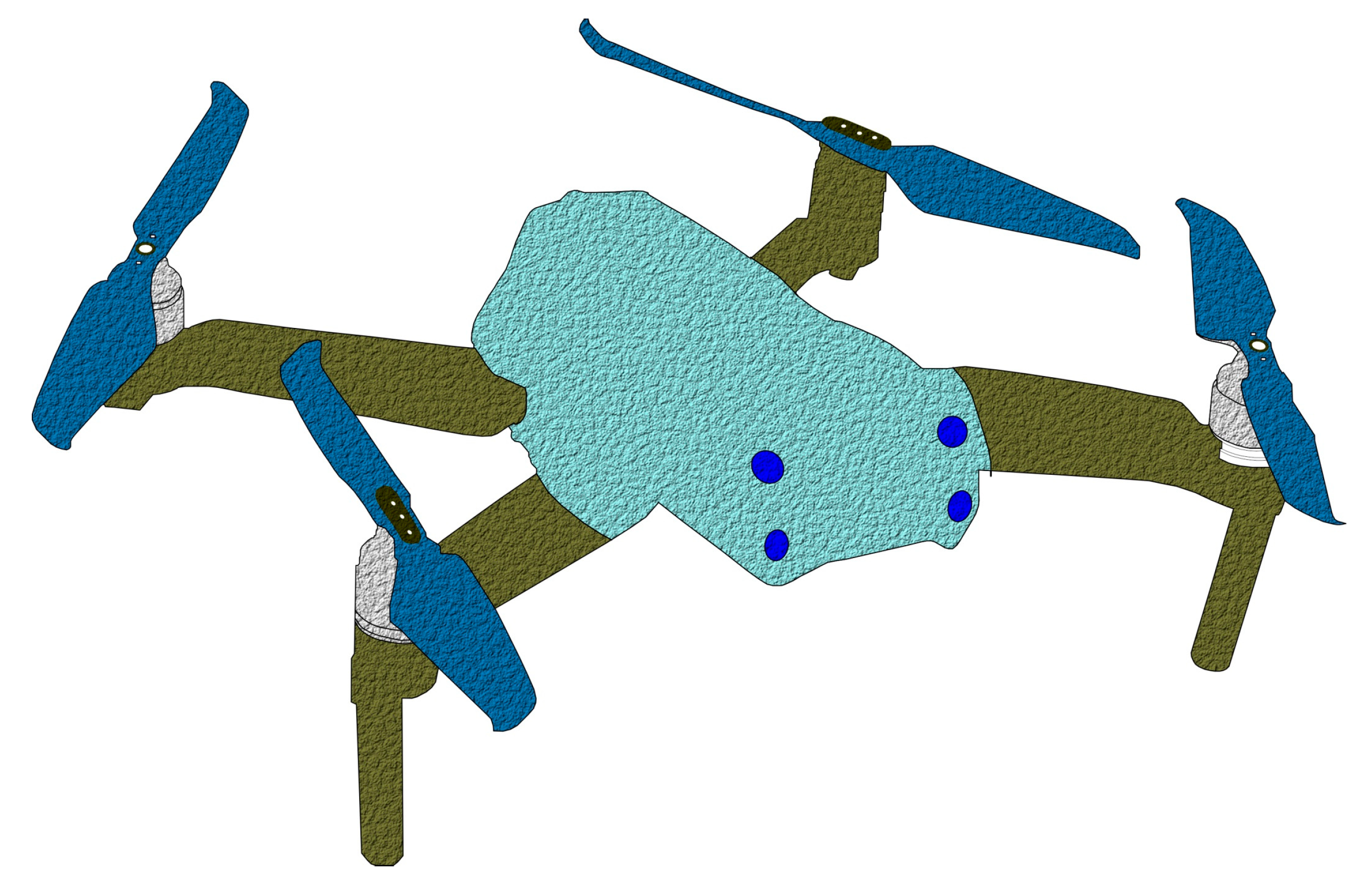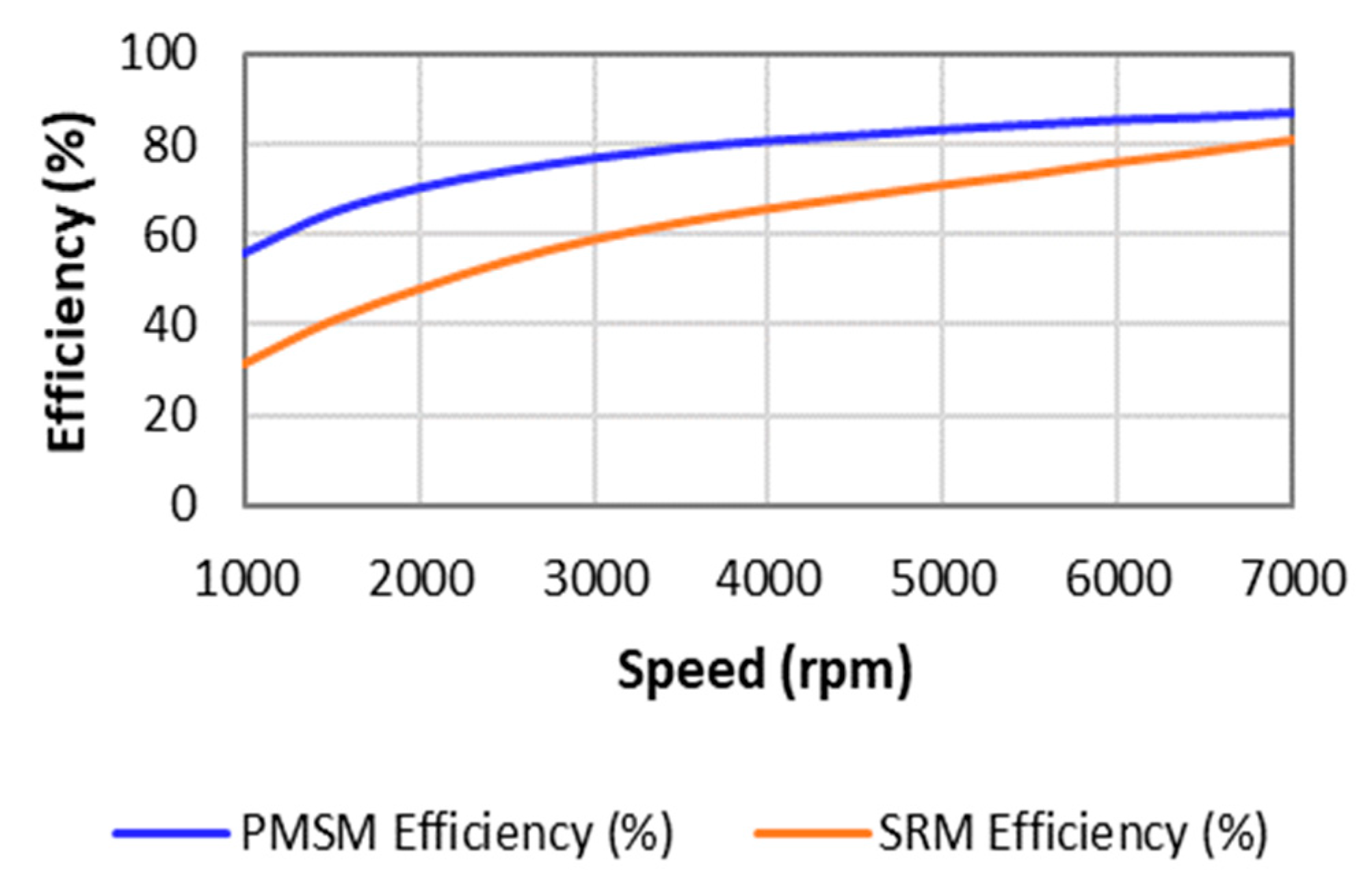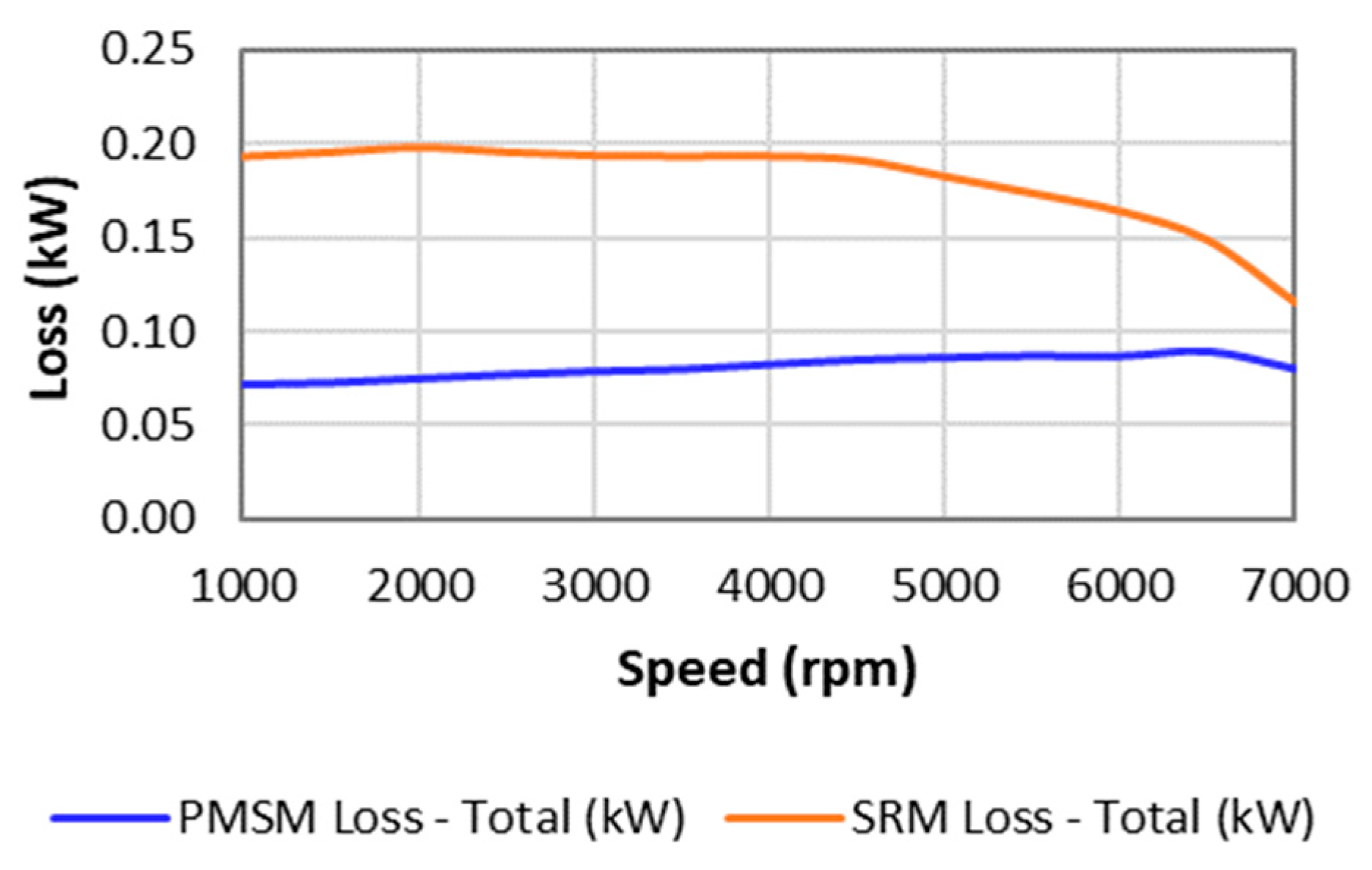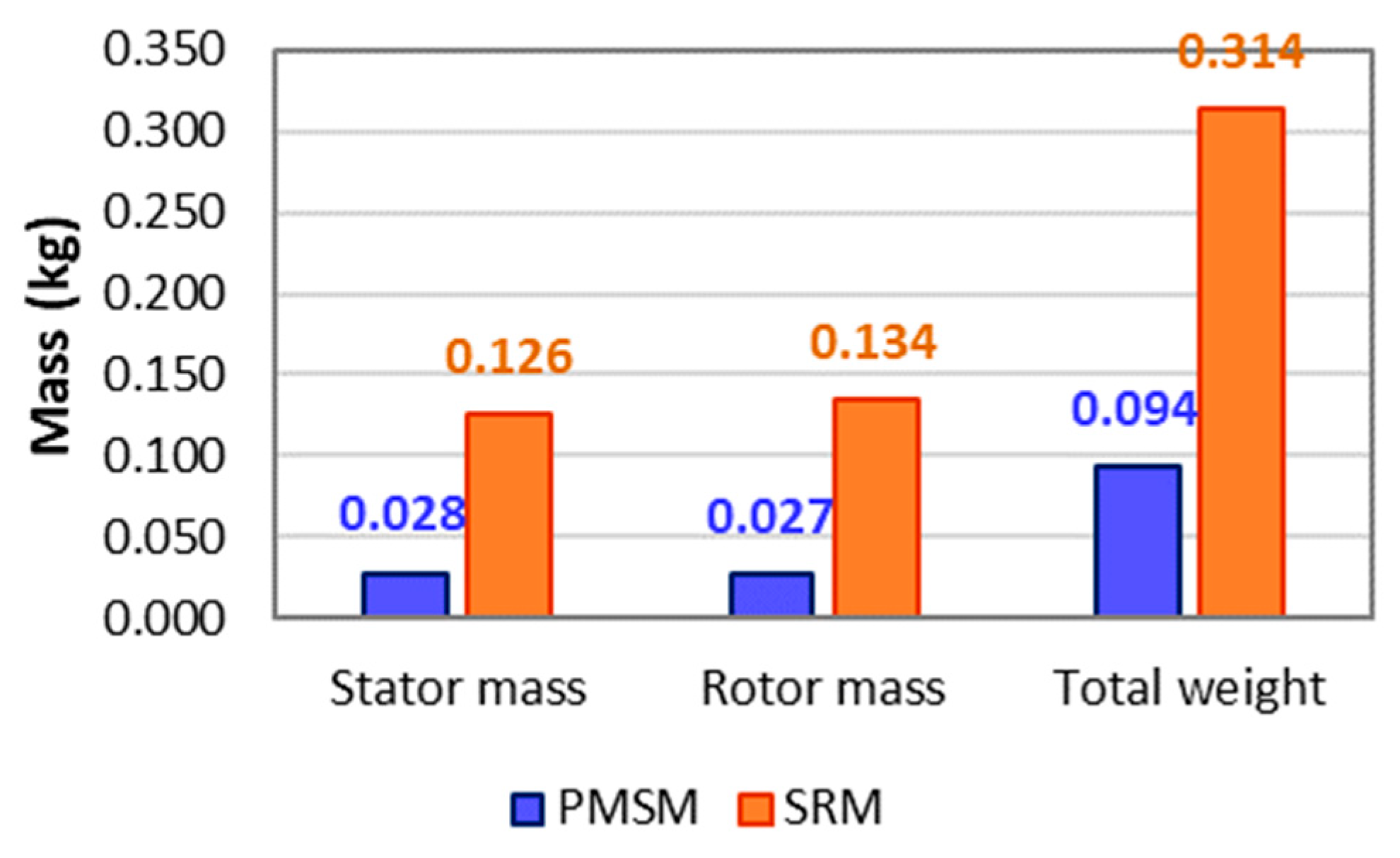Comparative Analysis of PMSMs and SRMs for Drone Applications †
Abstract
1. Introduction
2. Design Methodology
3. Results and Discussion
4. Conclusions
5. Future Work
- Selection of materials.
- Study of thermal and mechanical aspects.
- Suggestion of suitable control techniques.
- Hardware development.
Author Contributions
Funding
Institutional Review Board Statement
Informed Consent Statement
Data Availability Statement
Acknowledgments
Conflicts of Interest
References
- Etewa, M.; Hassan, A.F.; Safwat, E.; Abozied, M.A.H.; El-Khatib, M.M.; Ramirez-Serrano, A. Performance Estimation of Fixed-Wing UAV Propulsion Systems. Drones 2024, 8, 424. [Google Scholar] [CrossRef]
- Wang, M.; Chen, Z. Research on Permanent Magnet Structure of Permanent Magnet Synchronous Motor for Electric Vehicle. In Proceedings of the 2nd International Conference on Electrical Engineering and Control Science (IC2ECS), Nanjing, China, 16–18 December 2022; pp. 990–993. [Google Scholar]
- Zhao, L.; Yang, M.; He, Z.; Ma, J.; Lu, Q. Optimization Design of Outer-rotor Permanent Magnet Synchronous Motor. In Proceedings of the 2021 Sixteenth International Conference on Ecological Vehicles and Renewable Energies (EVER), Monte-Carlo, Monaco, 5–7 May 2021; pp. 1–5. [Google Scholar]
- Garip, S.; Yasa, Y. Design of Outer Runner-Type Brushless Permanent Magnet DC Motor for Lightweight E-Vehicles. In Proceedings of the 2020 6th International Conference on Electric Power and Energy Conversion Systems (EPECS), Istanbul, Turkey, 5–7 October 2020; pp. 151–156. [Google Scholar]
- Cao, Z.; Liu, J. Cogging Torque Reduction for Outer Rotor Interior Permanent Magnet Synchronous Motor. In Proceedings of the IECON 2020—The 46th Annual Conference of the IEEE Industrial Electronics Society, Singapore, 18–21 October 2020; pp. 2689–2693. [Google Scholar]
- Xie, Y.; Fu, L.; Ma, Z. Design and Research of Low-Speed High-Torque Permanent Magnet Synchronous Motor with Outer Rotor. In Proceedings of the 22nd International Conference on Electrical Machines and Systems (ICEMS), Harbin, China, 11–14 August 2019; pp. 1–5. [Google Scholar]
- Wang, X.; Zhang, Z.; Gao, P.; Lu, H.; He, X. Design and Simulation Analysis of a Novel Outer Rotor IPM Motor Used in Electric Vehicles. In Proceedings of the 13th World Congress on Intelligent Control and Automation (WCICA), Changsha, China, 4–8 July 2018; pp. 1413–1418. [Google Scholar]
- Kuantama, E.; Craciun, D.; Tarca, I.; Tarca, R. Quadcopter Propeller Design and Performance Analysis. In New Advances in Mechanisms, Mechanical Transmissions and Robotics; Corves, B., Lovasz, E.C., Hüsing, M., Maniu, I., Gruescu, C., Eds.; Mechanisms and Machine Science; Springer: Cham, Switzerland, 2017; Volume 46, pp. 269–277. [Google Scholar]
- Patel, S.R.; Gandhi, N.; Chaithanya, N.; Chaudhari, B.N.; Nirgude, A. Design and development of Switched Reluctance Motor for electric vehicle application. In Proceedings of the 2016 IEEE International Conference on Power Electronics, Drives and Energy Systems (PEDES), Trivandrum, India, 14–17 December 2016; pp. 1–6. [Google Scholar]
- Xu, Z.; Jeong, K.-I.; Lee, D.-H.; Ahn, J.-W. Preliminary Performance Evaluation of a Novel 12/8 Segmental Rotor Type SRM. In Proceedings of the 2016 19th International Conference on Electrical Machines and Systems (ICEMS), Chiba, Japan, 13–16 November 2016; pp. 1–5. [Google Scholar]









| Parameter | PMSM | SRM |
|---|---|---|
| Rated speed (rpm) | 6000 | 6000 |
| Airgap (mm) | 0.2 | 0.1 |
| Stack length (mm) | 7 | 15 |
| Poles | 30 | 12 S |
| Slots | 36 | 8 R |
| Outer diameter (mm) | 56 | 64 |
| Inner diameter (mm) | 36 | 46 |
| Turns | 48 | 80 |
| connection type | Star | Star |
| Core material | M-19 29Ga | M-19 29Ga |
| Rotor Speed (rpm) | 1000 | 2000 | 3000 | 4000 | 5000 | 6000 |
|---|---|---|---|---|---|---|
| Torque (Nm) | 0.85 | 0.84 | 0.84 | 0.84 | 0.83 | 0.83 |
| Torque ripple (Nm) | 0.04 | 0.04 | 0.04 | 0.04 | 0.03 | 0.03 |
| Input power (kW) | 0.16 | 0.25 | 0.34 | 0.43 | 0.52 | 0.61 |
| Output power (kW) | 0.09 | 0.18 | 0.26 | 0.35 | 0.44 | 0.52 |
| Efficiency (%) | 55.55 | 70.34 | 77.11 | 81.02 | 83.59 | 85.71 |
| Loss–Total (kW) | 0.07 | 0.07 | 0.08 | 0.08 | 0.09 | 0.09 |
| Rotor Speed (rpm) | 1000 | 2000 | 3000 | 4000 | 5000 | 6000 |
|---|---|---|---|---|---|---|
| Torque (Nm) | 0.86 | 0.90 | 0.91 | 0.91 | 0.88 | 0.80 |
| Torque ripple (Nm) | 0.34 | 0.28 | 0.26 | 0.25 | 0.23 | 0.21 |
| Input power (kW) | 0.29 | 0.39 | 0.48 | 0.58 | 0.64 | 0.66 |
| Output power (kW) | 0.09 | 0.19 | 0.29 | 0.38 | 0.46 | 0.50 |
| Efficiency (%) | 31.42 | 48.12 | 59.14 | 65.96 | 71.28 | 76.37 |
| Loss–Total (kW) | 0.19 | 0.20 | 0.19 | 0.19 | 0.18 | 0.16 |
Disclaimer/Publisher’s Note: The statements, opinions and data contained in all publications are solely those of the individual author(s) and contributor(s) and not of MDPI and/or the editor(s). MDPI and/or the editor(s) disclaim responsibility for any injury to people or property resulting from any ideas, methods, instructions or products referred to in the content. |
© 2025 by the authors. Licensee MDPI, Basel, Switzerland. This article is an open access article distributed under the terms and conditions of the Creative Commons Attribution (CC BY) license (https://creativecommons.org/licenses/by/4.0/).
Share and Cite
Vigneshwar, S.T.; Balaji, M.; Prabhu, S. Comparative Analysis of PMSMs and SRMs for Drone Applications. Eng. Proc. 2025, 93, 14. https://doi.org/10.3390/engproc2025093014
Vigneshwar ST, Balaji M, Prabhu S. Comparative Analysis of PMSMs and SRMs for Drone Applications. Engineering Proceedings. 2025; 93(1):14. https://doi.org/10.3390/engproc2025093014
Chicago/Turabian StyleVigneshwar, Sarangapani Theperumal, Mahadevan Balaji, and Sundaramoorthy Prabhu. 2025. "Comparative Analysis of PMSMs and SRMs for Drone Applications" Engineering Proceedings 93, no. 1: 14. https://doi.org/10.3390/engproc2025093014
APA StyleVigneshwar, S. T., Balaji, M., & Prabhu, S. (2025). Comparative Analysis of PMSMs and SRMs for Drone Applications. Engineering Proceedings, 93(1), 14. https://doi.org/10.3390/engproc2025093014






